Diagnostics of Secondary Fracture Properties Using Pressure Decline Data during the Post-Fracturing Soaking Process for Shale Gas Wells
Abstract
:1. Introduction
2. Pressure Decline Model during the Post-Fracturing Soaking Process
2.1. The Physical Model
2.2. Mathematical Model
2.2.1. Assumptions
- (1)
- The fracturing fluid is injected through the bottom hole, and the pumping process is considered to inject multiple stages at the same time. Each fracturing cluster creates one main fracture. The bridge plugs at all stages are completely dissolved and the wellbore is connected after the pumping treatment;
- (2)
- The gas–water two-phase flow and isothermal flow are considered in this model. Fluid is slightly compressible;
- (3)
- The gas flow in the main fractures is considered to be a high-velocity, non-Darcy flow. The gas flow in the secondary fractures is considered to obey Darcy flow conditions;
- (4)
- Consider the compressibility of the main fractures, secondary fractures, and shale matrix;
- (5)
- Consider matrix capillary imbibition.
2.2.2. Flow Conservation in Fractured Shale Reservoirs
2.2.3. Initial and Boundary Conditions
3. Numerical Simulation Method
| Variable, Symbol | Value | Variable, Symbol | Value |
|---|---|---|---|
| Main fracture half-length | 135 m | Rock compressibility | 4.4 × 10−4 MPa−1 |
| Main fracture conductivity | 8 D·cm | Gas compressibility | 0.03 MPa−1 |
| Main fracture porosity | 0.3 | Fracturing fluid viscosity | 0.8 mPa·s |
| Matrix permeability | 7 × 10−4 mD | Fracturing fluid density | 1000 kg/m3 |
| Matrix porosity | 0.06 | Initial water saturation | 0.35 |
| Secondary fracture permeability [23] | 0.01 mD | Initial reservoir pressure | 45 MPa |
| Secondary fracture porosity [24] | 0.055 | Gas viscosity | 0.058 mPa·s |
| Fracturing fluid compressibility | 4.8 × 10−7 MPa−1 | Secondary fracture closure coefficient [24] | 0.014 MPa−1 |
| Main fracture closure coefficient [24] | 0.0087 MPa−1 | Secondary fracture density [24] | 3 m−2 |
4. Results and Discussion
4.1. Simulation Results of Bottom-Hole Pressure Decline Characteristics
4.2. Comparison of Pressure Decline Characteristic Curves
4.3. Diagnostic Method Based on Simulated Pressure Decline Derivatives
5. Field Case Study
5.1. Geological and Construction Overview of the H49 Platform
5.2. Diagnostics of Hydraulic Fracture Properties
5.3. Calculation of Hydraulic Fracture Properties
6. Conclusions
- A wellbore fracture–network gas reservoir coupled fracturing shut-in pressure decline model is proposed. The simulated pressure derivatives show a “sawtooth” shape on a log–log plot, reflecting five fracture-dominated flow stages. Among them, stage ① is controlled by the main fracture, which is in the earliest stage and has the fastest pressure decline rate; the first V-shape (stages ② and ③) is controlled by the secondary fracture, which is in the middle stage of the soaking and the pressure decline rate slows down; and the second V-shape (stages ④ and ⑤) is controlled by the secondary fracture and matrix, which is in the late stage of the soaking and has a slow pressure decline rate;
- The sensitivity simulation results show that the length of the main fracture determines the duration of stage ① and the pressure decline derivative value at point A. While the conductivity of the main fracture has a weak influence on the shape of the pressure decline derivative, the density, width, and permeability of the secondary fractures determine the size ratio and concave–convex degree of the two V-shapes of the pressure decline characteristic curve;
- Based on the pressure decline simulation, a diagnostic method is established for analyzing the pressure decline data and calculation of the main and secondary fracture properties of hydraulically fractured shale gas wells;
- A field case application proves that the proposed method works well for platform wells. For the H49 Platform, it indicates that the extension of both the main fracture and secondary fracture is better than that of central wells. The secondary fracture of central wells is limited, so it intends to generate simple main fractures.
Author Contributions
Funding
Data Availability Statement
Conflicts of Interest
References
- Fu, Y.; Dehghanpour, H.; Ezulke, D.; Steven Jones, R., Jr. Estimating effective fracture pore volume from flowback data and evaluating its relationship to design parameters of multistage-fracture completion. SPE Prod. Oper. 2017, 32, 423–439. [Google Scholar] [CrossRef]
- Wang, F.; Li, B.; Chen, Q.; Zhang, S. Simulation of Proppant Distribution in Hydraulically Fractured Shale Network During Shut-in Periods. J. Pet. Sci. Eng. 2019, 178, 467–474. [Google Scholar] [CrossRef]
- Zhang, B.; Zhang, C.P.; Ma, Z.Y.; Zhou, J.P.; Liu, X.F.; Zhang, D.C.; Ranjith, P.G. Ranjith. Simulation study of micro-proppant carrying capacity of supercritical CO2 (Sc-CO2) in secondary fractures of shale gas reservoirs. Geoenergy Sci. Eng. 2023, 224, 211636. [Google Scholar] [CrossRef]
- Zhang, T.; Li, C.; Shi, Y.; Mu, K.; Wu, C.; Guo, J.; Lu, C. Numerical simulation of proppant directly entering complex fractures in shale ga. J. Nat. Gas Sci. Eng. 2022, 107, 104792. [Google Scholar] [CrossRef]
- Zhang, X.; Wang, R.; Shi, W.; Hu, Q.; Xu, X.; Shu, Z.; Yang, Y.; Feng, Q. Structure- and lithofacies-controlled natural fracture developments in shale: Implications for shale gas accumulation in the Wufeng-Longmaxi Formations, Fuling Field, Sichuan Basin, China. Geoenergy Sci. Eng. 2023, 223, 211572. [Google Scholar] [CrossRef]
- Soliman, M.Y. Analysis of Buildup Tests with Short Producing Time. SPE Form. Eval. 1986, 1, 363–371. [Google Scholar] [CrossRef]
- Bourdet, D.; Ayoub, J.A.; Pirard, Y.M. Use of Pressure Derivative in Well Test Interpretation. SPE Form. Eval. 1989, 4, 293–302. [Google Scholar] [CrossRef]
- Wang, F.; Xu, J.; Zhou, T.; Zhang, S. Pump-stopping pressure drop model considering transient leak-off of fracture network. Pet. Explor. Dev. 2023, 50, 416–423. [Google Scholar] [CrossRef]
- Soliman, M.; Azari, M.; Ansah, J.; Kabir, C.S. Review and Application of Short-Term Pressure Transient Testing of Wells. In Proceedings of the SPE Middle East Oil and Gas Show and Conference, Manama, Bahrain, 12–15 March 2005. [Google Scholar]
- Mohamed, I.M.; Nasralla, R.A.; Sayad, M.A.; Marongiu-Porcu, M.; Ehlig-Economides, C.A. Evaluation of After-closure Analysis Techniques for Tight and Shale Gas Formations. In Proceedings of the SPE Hydraulic Fracturing Technology Conference and Exhibition, The Woodlands, TX, USA, 24–26 January 2011. SPE-140136-MS. [Google Scholar]
- Marongiu-Porcu, M.; Ehlig-Economides, C.A.; Economides, M.J. Global model for fracture falloff analysis. In Proceedings of the SPE North American Unconventional Gas Conference and Exhibition, The Woodlands, TX, USA, 12–16 June 2011. [Google Scholar]
- Bachman, R.C.; Walters, D.A.; Hawkes, R.A.; Toussaint, F.; Settari, T. Reappraisal of the G Time Concept in Mini-Frac Analysis. In Proceedings of the SPE Annual Technical Conference and Exhibition, San Antonio, TX, USA, 8–10 October 2012. SPE-160169-MS. [Google Scholar]
- Liu, G.; Ehlig-Economides, C. Comprehensive before-closure model and analysis for fracture calibration injection falloff test. J. Pet. Sci. Eng. 2019, 172, 911–933. [Google Scholar] [CrossRef]
- Liu, G.; Ehlig-Economides, C. Practical considerations for diagnostic fracture injection test (DFIT) analysis. J. Pet. Sci. Eng. 2018, 171, 1133–1140. [Google Scholar] [CrossRef]
- Wang, H.; Elliott, B.; Sharma, M. Pressure Decline Analysis in Fractured Horizontal Wells: Comparison between Diagnostic Fracture Injection Test, Flowback, and Main Stage Falloff. SPE Drill. Complet. 2021, 36, 717–729. [Google Scholar] [CrossRef]
- MClure, M.W.; Jung, H.; Cramer, D.D.; Sharma, M.M. The Fracture Compliance Method for Picking Closure Pressure from Diagnostic Fracture- Injection Tests. SPE J. 2016, 21, 1321–1339. [Google Scholar] [CrossRef]
- Zanganeh, B.; Clarkson, C.R.; Hawkes, R.V. Reinterpretation of Fracture Closure Dynamics During Diagnostic Fracture Injection Tests. In Proceedings of the SPE Western Regional Meeting, Bakersfield, CA, USA, 23–27 April 2017. SPE185649-MS. [Google Scholar]
- Zanganeh, B.; Clarkson, C.R.; Jones, J.R. Reinterpretation of Flow Patterns During DFITs Based on Dynamic Fracture Geometry, Leakoff and Afterflow. In Proceedings of the SPE Hydraulic Fracturing Technology Conference and Exhibition, Muscat, Oman, 16–18 October 2018. [Google Scholar]
- Wang, F. Simulation of coupled hydro-mechanical-chemical phenomena in hydraulically fractured gas shale during fracturing-fluid flowback. J. Pet. Sci. Eng. 2018, 163, 16–26. [Google Scholar] [CrossRef]
- Hu, P.; Geng, S.; Liu, X.; Li, C.; Zhu, R.; He, X. A three-dimensional numerical pressure transient analysis model for fractured horizontal wells in shale gas reservoirs. J. Hydrol. 2023, 620, 129545. [Google Scholar] [CrossRef]
- McKee, C.R.; Bumb, A.C.; Kneolg, R.A. Stress-dependent permeability and porosity of coal and other geologic formations. SPE Form. Eval. 1988, 3, 81–91. [Google Scholar] [CrossRef]
- Zhang, T.; Li, X.; Li, J.; Feng, D.; Li, P.; Zhang, Z.; Chen, Y.; Wang, S. Numerical investigation of the well shut-in and fracture uncertainty on fluid-loss and production performance in gas-shale reservoirs. J. Nat. Gas Sci. Eng. 2017, 46, 421–435. [Google Scholar] [CrossRef]
- Jurus, W.J.; Whitson, C.H.; Golan, M. Modeling water flow in hydraulically-fractured shale wells. In Proceedings of the SPE Annual Technical Conference and Exhibition, New Orleans, LA, USA, 30 September–2 October 2013. [Google Scholar]
- Ren, W.; Lau, H.C. Analytical modeling and probabilistic evaluation of gas production from a hydraulically fractured shale reservoir using a quad-linear flow model. J. Pet. Sci. Eng. 2020, 184, 106516. [Google Scholar] [CrossRef]
- Wang, F.; Chen, Q. A multi-mechanism multi-pore coupled salt flowback model and field application for hydraulically fractured shale wells. J. Pet. Sci. Eng. 2021, 196, 108013. [Google Scholar] [CrossRef]
- Warpinski, N.R.; Griffin, L.G.; Davis, E.J. Improving hydraulic frac diagnostics by joint inversion of downhole microseismic and tiltmeter data. In Proceedings of the SPE Annual Technical Conference and Exhibition, San Antonio, TX, USA, 24–27 September 2006. [Google Scholar]

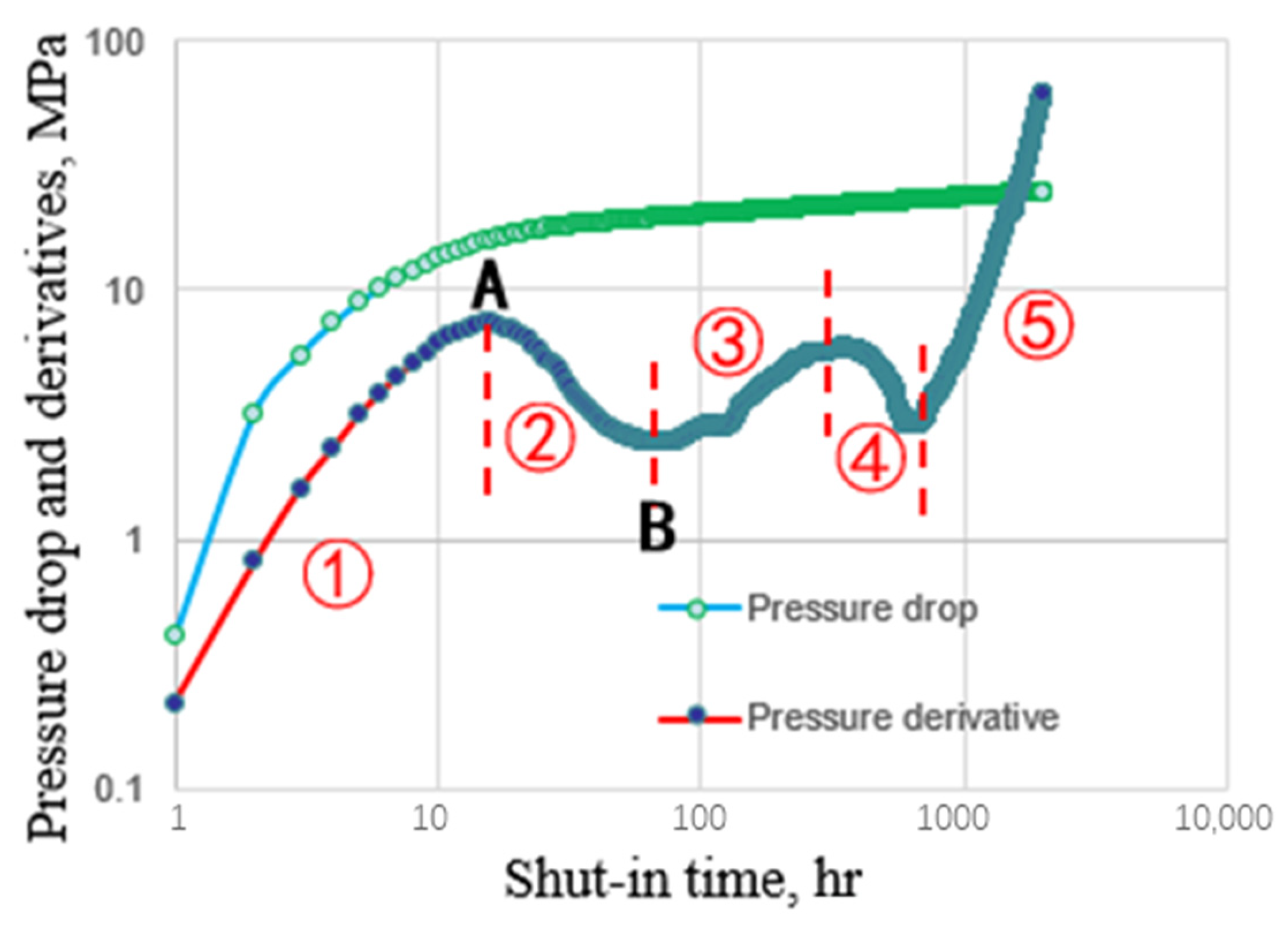
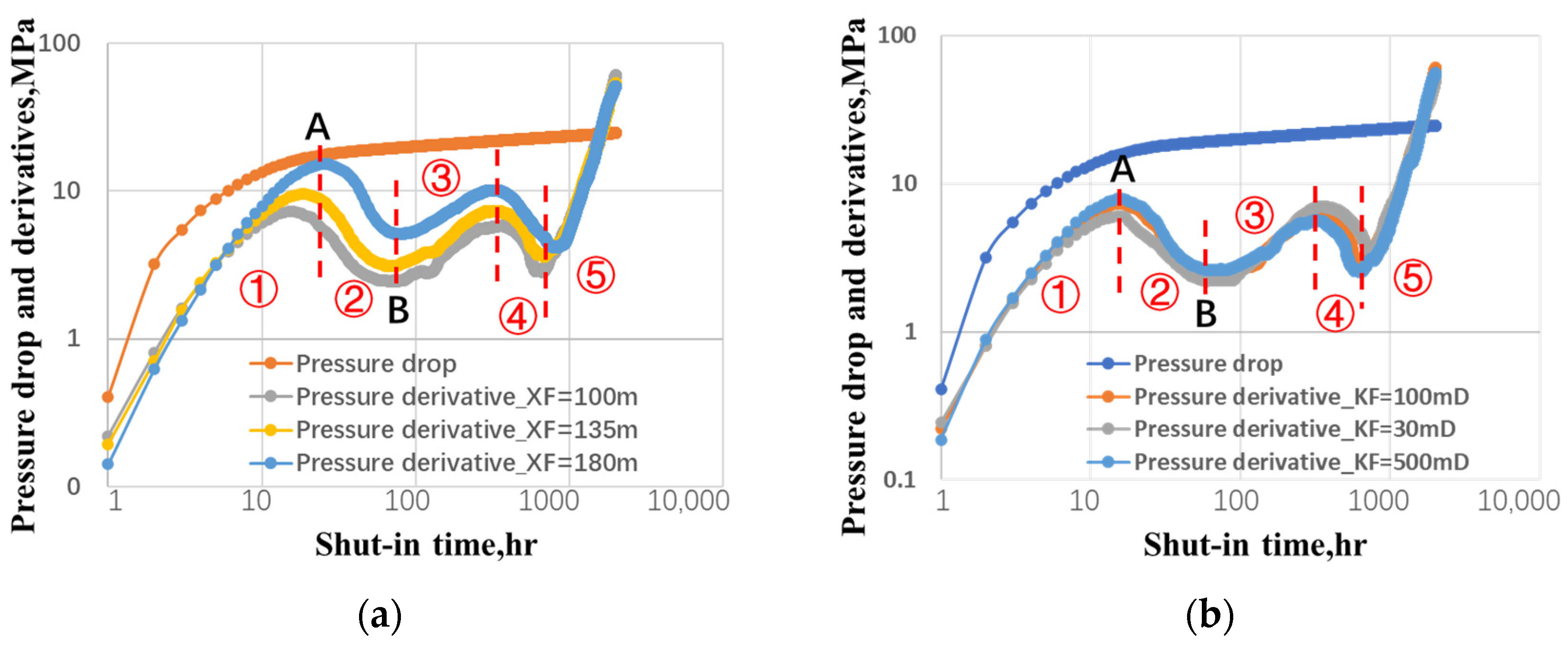
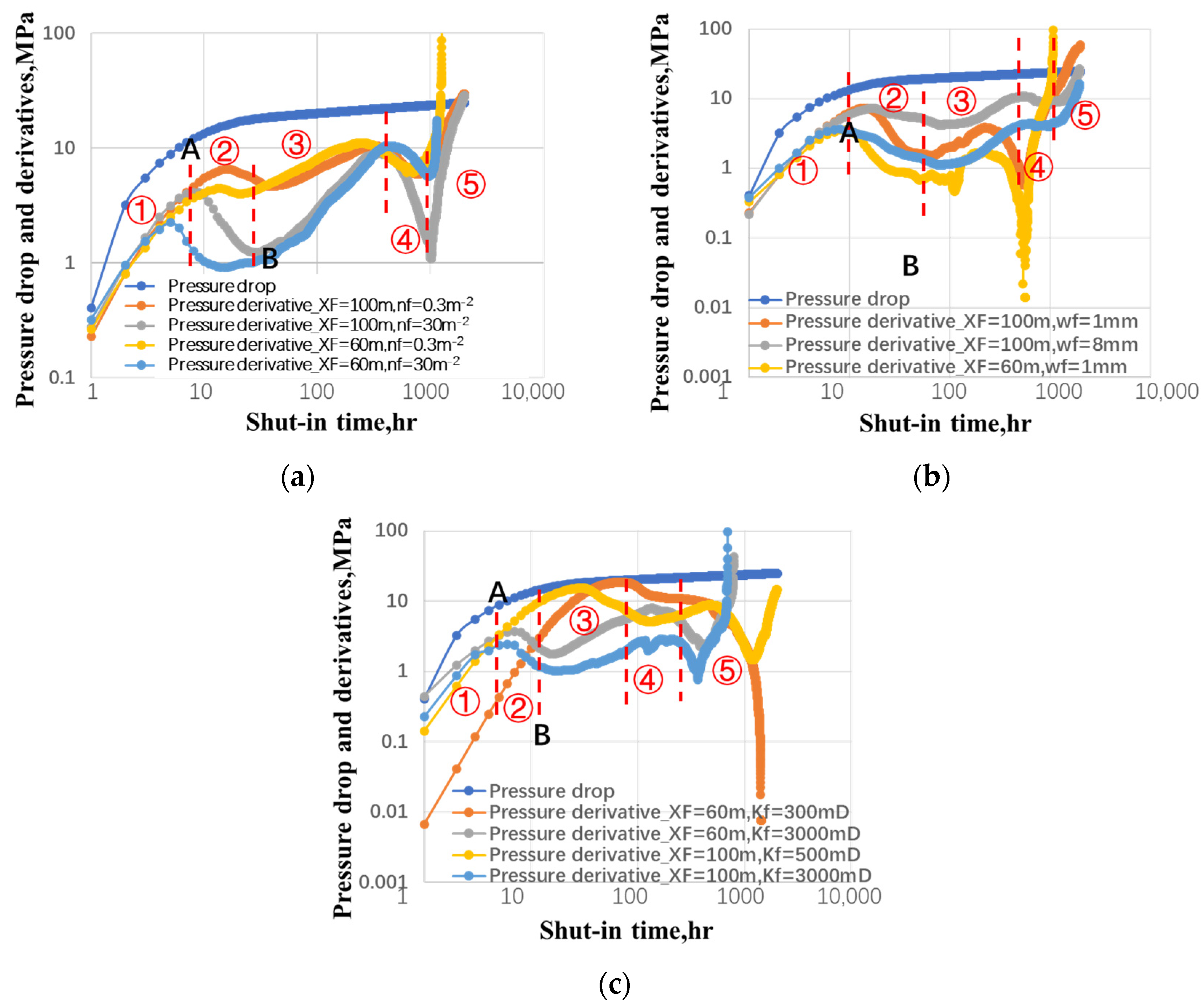
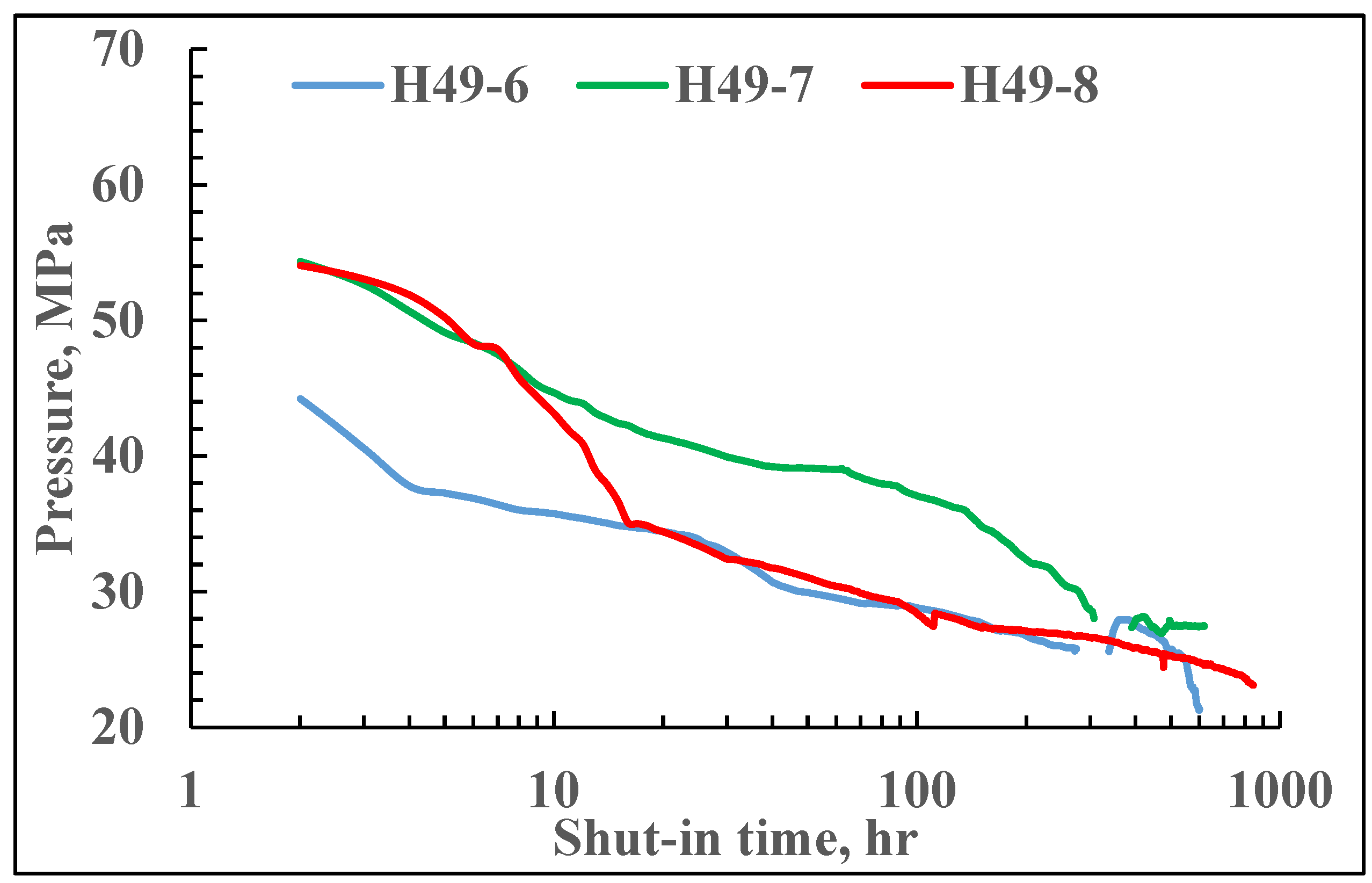
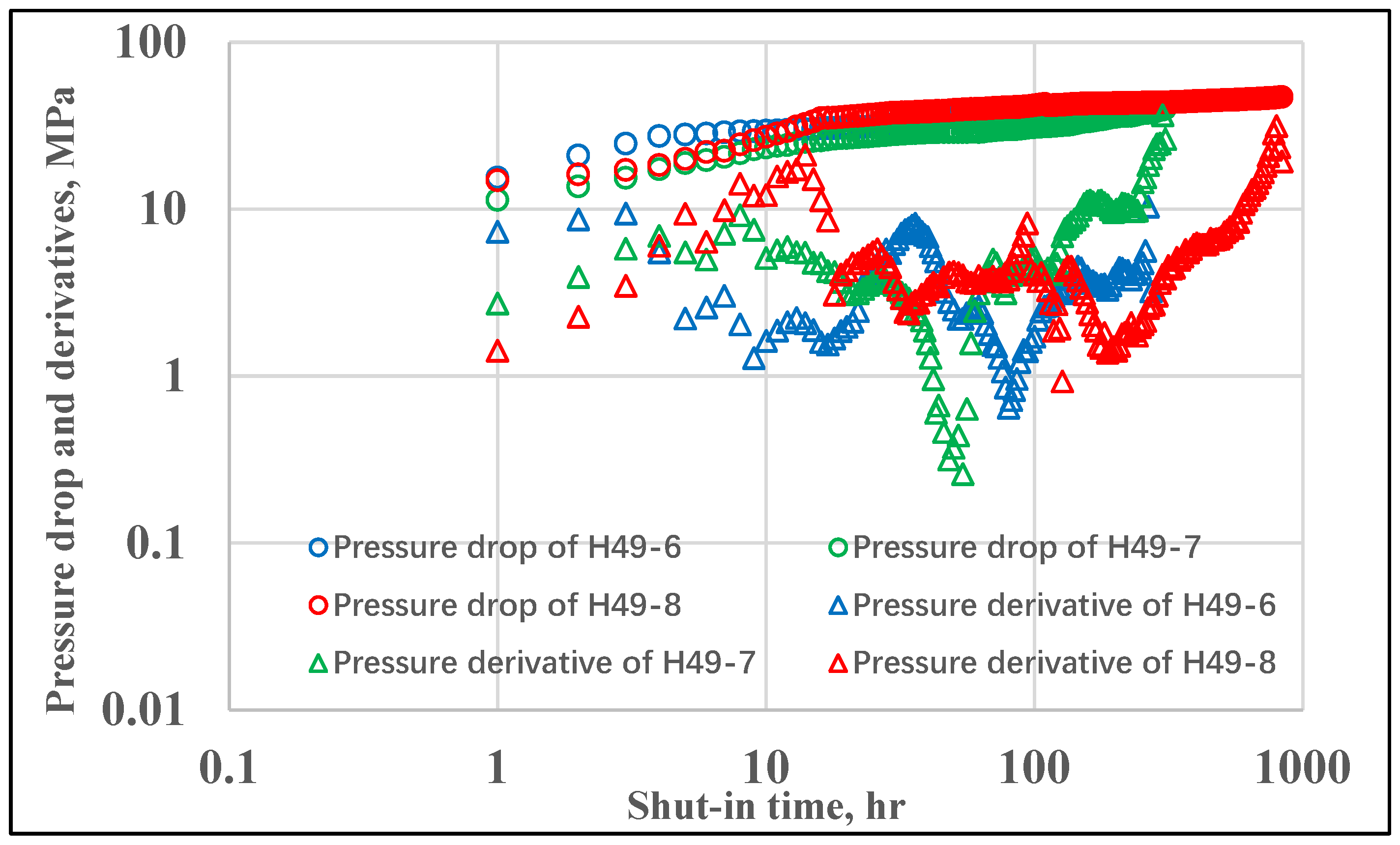

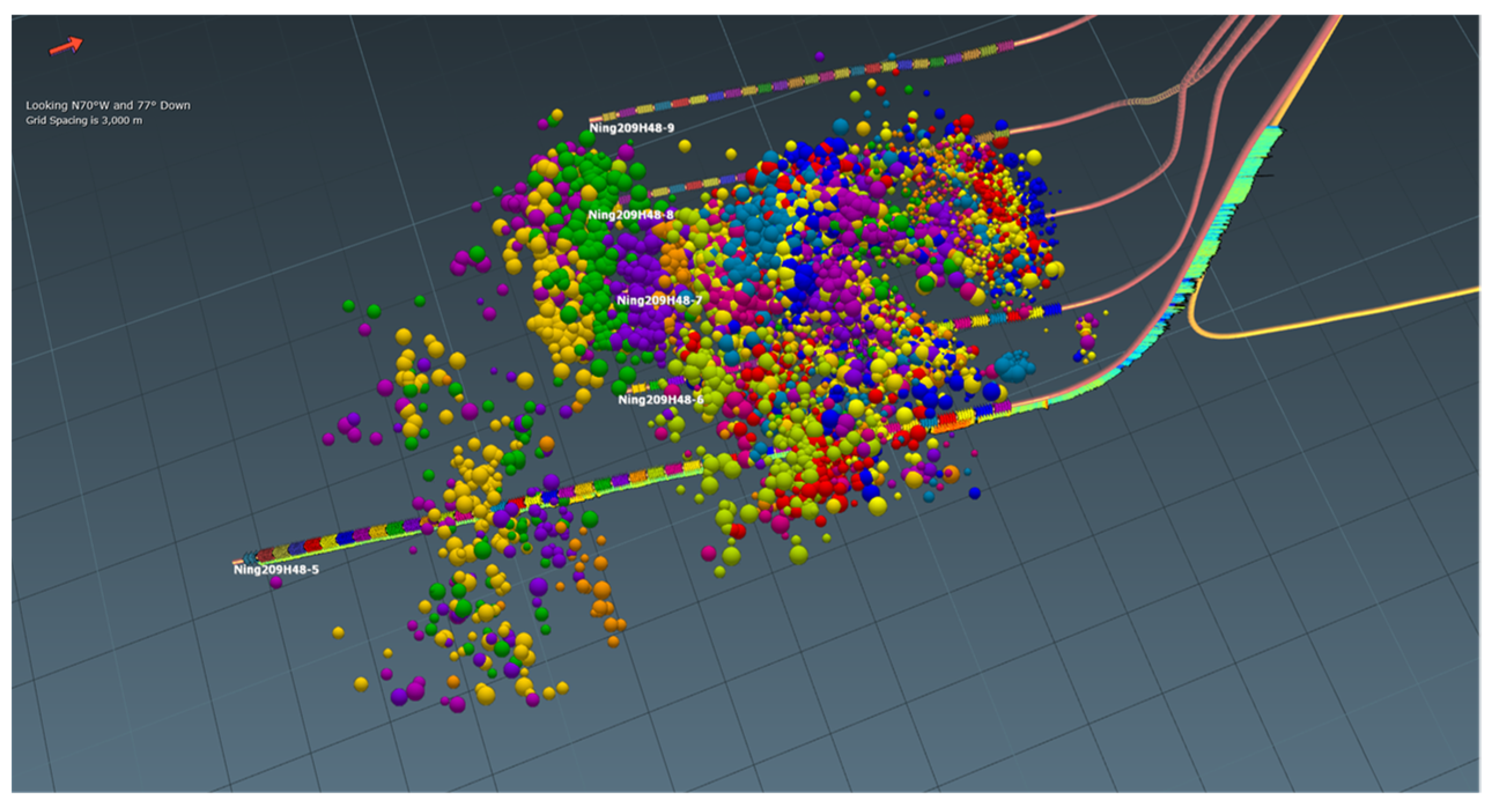
| Well | Vertical Depth (m) | Lateral Length (m) | Number of Stages | Number of Clusters | Fluid Volume (m3) | Proppant Volume (t) | Fracturing Time (d) | Shut-in Time (h) |
|---|---|---|---|---|---|---|---|---|
| H49-6 | 2798 | 1840 | 28 | 192 | 48,280 | 4172 | 50 | 599 |
| H49-7 | 2814 | 1850 | 27 | 228 | 48,374 | 3820 | 27 | 611 |
| H49-8 | 2857 | 2064 | 32 | 254 | 57,808 | 5348 | 14 | 832 |
| Parameters of Fracture Properties | H49-6 | H49-7 | H49-8 |
|---|---|---|---|
| Main fracture half-length (m) | 62 ± 2.5 | 70 ± 2.5 | 90 ± 2.5 |
| Main fracture conductivity (D·cm) | 9 | 10 | 9 |
| Secondary fracture permeability (mD) | 0.08 | 0.05 | 0.07 |
| Secondary fracture density (m−2) | 4.21 | 3.16 | 4.93 |
Disclaimer/Publisher’s Note: The statements, opinions and data contained in all publications are solely those of the individual author(s) and contributor(s) and not of MDPI and/or the editor(s). MDPI and/or the editor(s) disclaim responsibility for any injury to people or property resulting from any ideas, methods, instructions or products referred to in the content. |
© 2024 by the authors. Licensee MDPI, Basel, Switzerland. This article is an open access article distributed under the terms and conditions of the Creative Commons Attribution (CC BY) license (https://creativecommons.org/licenses/by/4.0/).
Share and Cite
Wu, J.; Ren, L.; Chang, C.; Sheng, S.; Zhu, J.; Liu, S.; Xie, W.; Wang, F. Diagnostics of Secondary Fracture Properties Using Pressure Decline Data during the Post-Fracturing Soaking Process for Shale Gas Wells. Processes 2024, 12, 239. https://doi.org/10.3390/pr12020239
Wu J, Ren L, Chang C, Sheng S, Zhu J, Liu S, Xie W, Wang F. Diagnostics of Secondary Fracture Properties Using Pressure Decline Data during the Post-Fracturing Soaking Process for Shale Gas Wells. Processes. 2024; 12(2):239. https://doi.org/10.3390/pr12020239
Chicago/Turabian StyleWu, Jianfa, Liming Ren, Cheng Chang, Shuyao Sheng, Jian Zhu, Sha Liu, Weiyang Xie, and Fei Wang. 2024. "Diagnostics of Secondary Fracture Properties Using Pressure Decline Data during the Post-Fracturing Soaking Process for Shale Gas Wells" Processes 12, no. 2: 239. https://doi.org/10.3390/pr12020239





